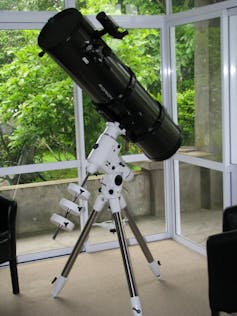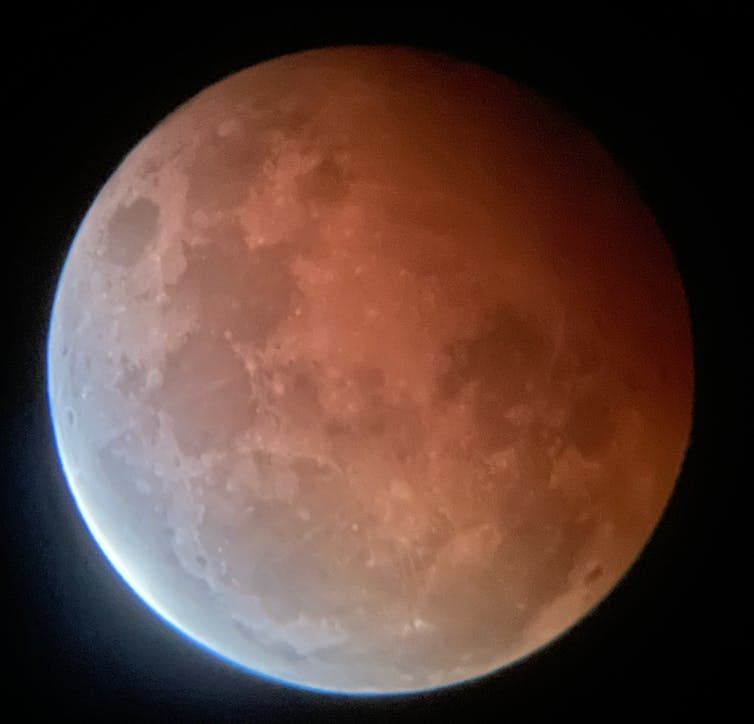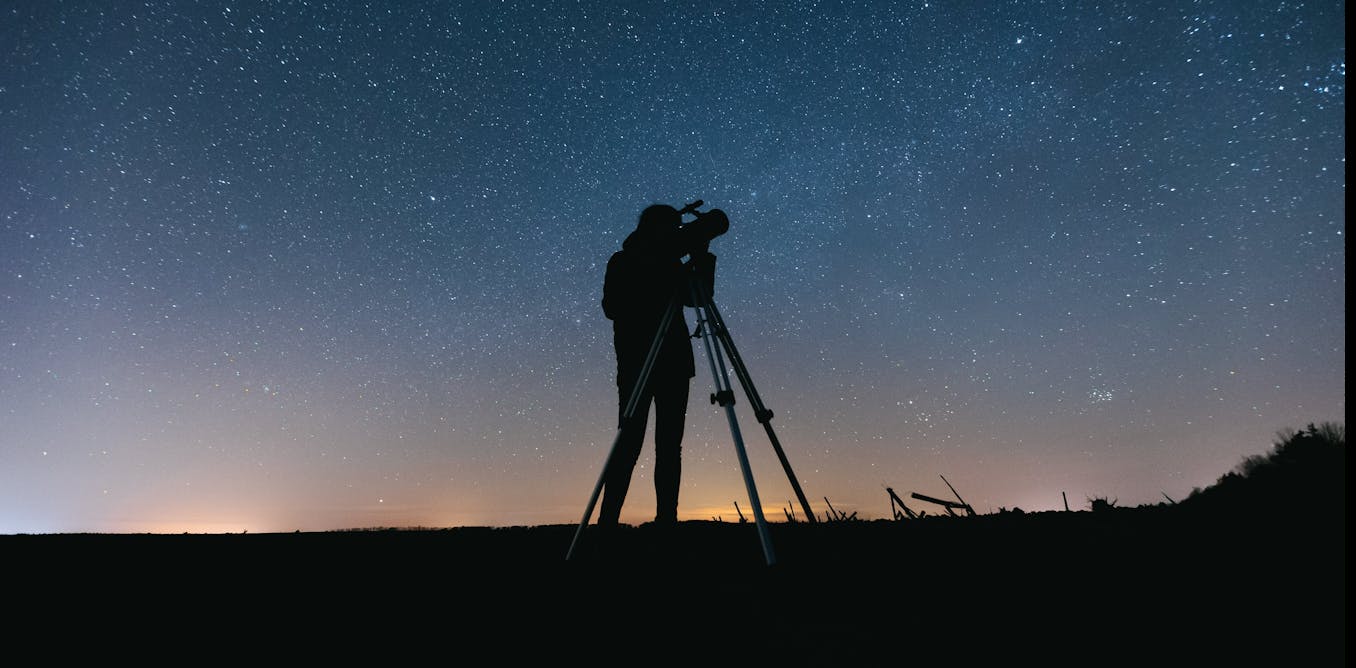While the naked eye or binoculars can reveal much of the night sky, a telescope reveals much more. Seeing Saturn's rings or moon craters with your own eyes can be a wonderful moment.
However, choosing the right telescope can be difficult. There are telescopes with lenses and telescopes with mirrors. Telescopes that are hand-cranked and electronically controlled. Telescopes also come in different sizes, with the trade-off between light-gathering power, portability, and price.
Although there's a lot to consider, changes in prices and technology mean that stunning views of the cosmos are more accessible than they were just a decade ago.
Read more: Do you want to enter the world of stars? A professional astronomer explains where to start
How big should the hole be?
Aperture is fundamental to telescopes. The larger the lens or mirror collecting the light, the fainter the objects you can see. Double the aperture from 50mm diameter to 100mm diameter, and the light collecting area will quadruple.
Michael Brown
The aperture also limits the level of detail you can see, due to the diffraction (interference) of light.
Again, bigger is better – a telescope with a larger aperture will produce sharper images than a smaller aperture telescope of similar design. The Earth's turbulent atmosphere also distorts images, which may limit the details that can be seen when the aperture is larger than 150 mm.
Inexpensive telescopes are sometimes advertised by magnification, but a small telescope with high magnification makes blurry images larger without revealing more detail.
Refractor or reflector?
Should you buy a refracting telescope or a reflecting mirror? It depends on what you want to look at, and your budget.
Refracting telescopes
Refracting telescopes It can be good for viewing objects on the ground and in the sky. Refracting telescopes with short focal lengths (where the light is focused close to the eyepiece) can be quite compact and are good for low-magnification views, which is great for scanning dark country skies.
However, there is a catch. While 70mm aperture refracting telescopes can be quite affordable, larger refracting telescopes are often more expensive than comparable reflecting telescopes.
Refracting telescopes also suffer from chromatic aberration – where different colors are not brought into common focus – and this is especially noticeable at high magnification when stars get colored halos. This can be mitigated by using complex lens designs, but this increases the cost.
Reflecting telescopes
Reflecting telescopes Use mirrors to focus light. These tend to be larger and do not suffer from chromatic aberration.
Dobsonian telescopes Featuring a simple Newtonian optical design and wooden holders, they are a very cost-effective (if sometimes bulky) option for larger apertures. Schmidt Cassegrain Maksutov telescopes, which use a combination of lenses and mirrors, are more compact (a big plus), but also more complex and expensive.

Wotichai Charonburi/Flickr, CC by
How can I find objects in the sky? Depends on the mountain
Do you want to look at a celestial body? You'll need to point your telescope in the right direction, keep it stationary, and follow the object as it moves across the sky (due to the Earth's rotation).
To do this, a telescope It needs a mount, which is often sold with the telescope but can also be purchased separately. Mountains fall into two broad categories.
Tropical mountains It has an axis that is in line with the Earth's axis, so a single motor can compensate for the Earth's rotation. These mounts were necessary to take long-exposure images with telescopes before computers and tended to be relatively heavy.

Mike White/Flickr, CC BY-NC-ND
Alternate azimuth mounts They have a vertical and horizontal axis (how a camera is mounted on a tripod, for example), and tend to be cheaper and lighter than equatorial mounts. With the advent of cheap computing, they can now be used to automatically point to and track celestial objects.
To point the telescope at celestial objects, you can move it manually or have electronics help you, including “goto” mounts with motors that move the telescope for you.
A fully manual telescope will be cheaper than an automated telescope, but you will need to navigate the sky yourself.
Electronic assistance to navigate in the sky is developing rapidly and becoming cheaper. Many telescopes on the market now use GPS and a smartphone app, which simplifies the process and makes everything more portable.
Do I need a finder scope?
No matter how you aim your telescope, having an additional “finder” scope with a 30-50mm aperture can be useful for small telescopes and essential for larger telescopes.
Large telescopes usually view a small patch of sky, making finding your way around difficult. A wider view finder scope and crosshairs simplify things. Even telescopes with goto electronics often need to be calibrated using bright stars and are easier to locate using a find scope.
What about the lens?
An essential part of most telescopes is Lens I looked through. Good telescopes are sometimes sold with very cheap lenses, but upgrading to better ones can be relatively inexpensive.
A good start is a low-magnification lens for sweeping views, and a high-magnification lens for planets.
Plössl lenses Reasonably priced and offers good views. More sophisticated lenses that provide better vision are also available, and are much cheaper than they used to be.
If you want to look at the sun, you have to He should Get custom designed Solar filter. Never point a telescope (including a search scope) at the Sun without filters – this can permanently damage the eyes and shatter the lenses.
What if I want to take astrophotos?
Taking basic astrophoto images has become much easier with smartphones. Although you can hold your phone in front of a telescope lens to take a photo of the moon or planet, you'll get better results with an adapter that holds your phone securely in place.

Michael Brown
Of course, better images can be taken with astronomy cameras that can take very short exposures (for planets) or very long exposures (for nebulae and faint galaxies). For long exposures, automatic tracking of celestial objects is essential, which increases the price of the telescope.
Smart telescopes It is a relatively recent addition to the market. These goto telescopes have no eyepieces and take images only electronically. Since modern detectors are more sensitive than our eyes, they can capture extremely stunning images using a relatively small portable telescope, even when there is light pollution.
However, you lose the experience of seeing the universe directly with your own eyes through the lens.
Try before you buy!

Michael Brown
If there is a local amateur astronomy society, you can sign up or attend a star party. There must be a lot of telescopes, and the owners will be happy to sing about them.
A specialty shop can also offer a first-hand experience of the telescope: its size and how it works (with restrictions during the day). For example, you may find that a telescope is too large or too technical for your needs.
Shopping online can save money, but may have less customer support than a local store. You can also get a used deal, and the seller may allow you to test his telescope on the moon and planets before purchasing.
There is a lot to consider before purchasing a telescope. Aperture, size, cost and other factors must be considered. But there are many good options available, and with a good choice you can see some great things. And you might have a “wow” moment.

“Amateur organizer. Wannabe beer evangelist. General web fan. Certified internet ninja. Avid reader.”




/cdn.vox-cdn.com/uploads/chorus_asset/file/25550621/voultar_snes2.jpg)


More Stories
Watch a Massive X-Class Solar Explosion From a Sunspot Facing Earth (Video)
New Study Challenges Mantle Oxidation Theory
The theory says that complex life on Earth may be much older than previously thought.